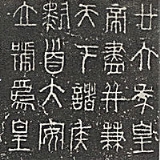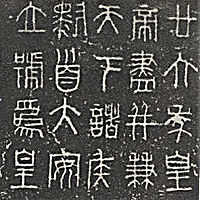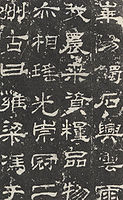
East asian script styles
Encyclopedia
In Chinese calligraphy, Chinese characters can be written according to five major styles. These styles are intrinsically linked to the history of Chinese script.
Characters are often written in ancient variations or simplifications that deviate from the modern standards used in Chinese, Japanese, Vietnamese or Korean. Modern variations or simplifications of characters, akin to Chinese Simplified characters or Japanese shinjitai
, are occasionally used, especially since some simplified forms derive from cursive script shapes in the first place.
The Japanese syllabaries of katakana and hiragana are used in calligraphy; the katakana
were derived from the shapes of regular script characters and hiragana
from those of cursive script. In Korea, the post-Korean War
period saw the increased use of hangul
, the Korean alphabet, in calligraphy.
 The seal script (often called "small seal" script) is the formal script of the Qín
The seal script (often called "small seal" script) is the formal script of the Qín
system of writing, which evolved during the Eastern Zhōu dynasty in the state of Qín
and was imposed as the standard in areas Qín gradually conquered. Although some modern calligraphers practice the most ancient oracle bone script
as well as various other scripts older than seal script found on Zhōu dynasty
bronze inscriptions, seal script is the oldest style that continues to be widely practiced.
Today, this style of Chinese writing is used predominantly in seals, hence the English name. Although seals (name chops), which make a signature-like impression, are carved in wood, jade and other materials, the script itself was originally written with brush and ink on bamboo books and other media, just like all other ancient scripts.
Most people today cannot read the seal script, so it is considered an ‘ancient’ script, generally not used outside the fields of calligraphy and carved seals. However, because seals act like legal signature
s in the cultures of China, Japan, Korea, and Vietnam, and because vermillion seal impressions are a fundamental part of the presentation of works of art such as calligraphy and painting, seals and therefore seal script remain ubiquitous.
to Qín Dynasty
, which then developed into clerical script in the early Western Hàn dynasty, and matured stylistically thereafter.
Clerical script characters are often "flat" in appearance, being wider than the preceding seal script and the modern standard script, both of which tend to be taller than they are wide; some versions of clerical are square, and others are wider. Compared with the preceding seal script, forms are strikingly rectilinear; however, some curvature and some seal script influence often remains. Seal script tended towards uniformity of stroke width, but clerical script gave the brush freer rein, returning to the variations in width seen in early Zhōu brushwork. Most noticeable is the dramatically flared tail of one dominant horizontal or downward-diagonal stroke, especially that to the lower right. This characteristic stroke has famously been called 'silkworm head and wild goose tail' (蠶頭雁尾 cántóu yànwěi)in Chinese) due to its distinctive shape.
The archaic clerical script or ‘proto-clerical’ of the Chinese Warring States period
to Qín Dynasty
and early Hàn Dynasty
can often be difficult to read for a modern East Asian person, but the mature clerical script of the middle to late Hàn dynasty is generally legible. Modern calligraphic works and practical applications (e.g., advertisements) in the clerical script tend to use the mature, late Hàn style, and may also use modernized character structures, resulting in a form as transparent and legible as regular (or standard) script. The clerical script remains common as a typeface used for decorative purposes (for example, in displays), but other than in artistic calligraphy, adverts and signage, it is not commonly written.
In general, an educated person in China or Japan can read characters written in the semi-cursive script with relative ease, but may have occasional difficulties with certain idiosyncratic shapes.
Entire characters may be written without lifting the brush from the paper at all, and characters frequently flow into one another. Strokes are modified or eliminated completely to facilitate smooth writing and to create a beautiful, abstract appearance. Characters are highly rounded and soft in appearance, with a noticeable lack of angular lines. Due to the drastic simplification and ligature involved, this script is not considered particularly legible to the average person, and thus has never achieved widespread use beyond the realm of literati calligraphers.
The cursive script is the source of Japanese hiragana, as well as many modern simplified forms in Simplified Chinese characters and Japanese shinjitai.
 The regular script (often called "standard" script or simply ‘kǎishū’) is one of the last major calligraphic styles to develop, emerging between the Chinese Hàn dynasty and Three Kingdoms
The regular script (often called "standard" script or simply ‘kǎishū’) is one of the last major calligraphic styles to develop, emerging between the Chinese Hàn dynasty and Three Kingdoms
period, gaining dominance in the Southern and Northern Dynasties
, and maturing in the Táng Dynasty
. It emerged from a neatly written, early period semi-cursive form of clerical script
. As the name suggests, the regular script is "regular", with each of the strokes placed slowly and carefully, the brush lifted from the paper and all the strokes distinct from each other.
The regular script is also the most easily and widely recognized style, as it is the script to which children in East Asian countries and beginners of East Asian languages are first introduced. For learners of calligraphy, the regular script is usually studied first to give students a feel for correct placement and balance, as well as to provide a proper base for the other, more flowing styles.
In the regular script samples to the right, the characters in the left column are in Traditional Chinese while those to the right are in Simplified Chinese.
, characters created in the Edo
period of Japanese history, such as sumōmoji (sumo letters) used to write sumō
wrestling posters, kanteiryū, used for kabuki
, higemoji, and so on. These styles are typically not taught in Japanese calligraphy schools.
Chinese and Korean people can read edomoji, but the style has a distinct Japanese feel to it. It is therefore commonly used in China and Korea to advertise Japanese restaurants.
Ancient characters
Styles
| English name | Chinese (trad. Traditional Chinese character Traditional Chinese characters refers to Chinese characters in any character set which does not contain newly created characters or character substitutions performed after 1946. It most commonly refers to characters in the standardized character sets of Taiwan, of Hong Kong, or in the Kangxi... Hanzi) Japanese (Kanji Kanji Kanji are the adopted logographic Chinese characters hanzi that are used in the modern Japanese writing system along with hiragana , katakana , Indo Arabic numerals, and the occasional use of the Latin alphabet... ) Korean (Hanja Hanja Hanja is the Korean name for the Chinese characters hanzi. More specifically, it refers to those Chinese characters borrowed from Chinese and incorporated into the Korean language with Korean pronunciation... ) Vietnamese (Hán tự) |
Chinese (Hanzi - simplified Simplified Chinese character Simplified Chinese characters are standardized Chinese characters prescribed in the Xiandai Hanyu Tongyong Zibiao for use in Mainland China. Along with traditional Chinese characters, it is one of many standard character sets of the contemporary Chinese written language... ) |
Chinese, Mandarin (Pinyin Pinyin Pinyin is the official system to transcribe Chinese characters into the Roman alphabet in China, Malaysia, Singapore and Taiwan. It is also often used to teach Mandarin Chinese and spell Chinese names in foreign publications and used as an input method to enter Chinese characters into... ) |
Japanese (Hepburn Romaji) | Korean (Hangul Hangul Hangul,Pronounced or ; Korean: 한글 Hangeul/Han'gŭl or 조선글 Chosŏn'gŭl/Joseongeul the Korean alphabet, is the native alphabet of the Korean language. It is a separate script from Hanja, the logographic Chinese characters which are also sometimes used to write Korean... ) |
Korean (Revised Romanization Revised Romanization of Korean The Revised Romanization of Korean is the official Korean language romanization system in South Korea proclaimed by Ministry of Culture, Sports and Tourism, replacing the older McCune–Reischauer system... ) |
Vietnamese (Quốc ngữ) |
|---|---|---|---|---|---|---|---|
| Seal script Seal script Seal script is an ancient style of Chinese calligraphy. It evolved organically out of the Zhōu dynasty script , arising in the Warring State of Qin... (Small seal) |
|||||||
| Clerical script Clerical script The clerical script , also formerly chancery script, is an archaic style of Chinese calligraphy which evolved in the Warring States period to the Qin dynasty, was dominant in the Han dynasty, and remained in use through the Wèi-Jìn periods... (Official script) |
(Jpn: ) |
||||||
| Semi-cursive script Semi-cursive script Semi-cursive script is a cursive style of Chinese characters. Because it is not as abbreviated as cursive, most people who can read regular script can read semi-cursive.... (Running script) |
|||||||
| Cursive script Cursive script (East Asia) Cursive script , sometimes translated as Grass script is a style of Chinese calligraphy. Cursive script is faster to write than other styles, but difficult to read for those unfamiliar with it. It functions primarily as a kind of shorthand script or calligraphic style... (Grass script) |
|||||||
| Regular script Regular script Regular script , also called 正楷 , 真書 , 楷体 and 正書 , is the newest of the Chinese script styles Regular script , also called 正楷 , 真書 (zhēnshū), 楷体 (kǎitǐ) and 正書 (zhèngshū), is the newest of the Chinese script styles Regular script , also called 正楷 , 真書 (zhēnshū), 楷体 (kǎitǐ) and 正書 (zhèngshū), is... (Standard script) |
 |
 |
 |
 |
 |
Characters are often written in ancient variations or simplifications that deviate from the modern standards used in Chinese, Japanese, Vietnamese or Korean. Modern variations or simplifications of characters, akin to Chinese Simplified characters or Japanese shinjitai
Shinjitai
Shinjitai are the forms of kanji used in Japan since the promulgation of the Tōyō Kanji List in 1946. Some of the new forms found in shinjitai are also found in simplified Chinese, but shinjitai is generally not as extensive in the scope of its modification...
, are occasionally used, especially since some simplified forms derive from cursive script shapes in the first place.
The Japanese syllabaries of katakana and hiragana are used in calligraphy; the katakana
Katakana
is a Japanese syllabary, one component of the Japanese writing system along with hiragana, kanji, and in some cases the Latin alphabet . The word katakana means "fragmentary kana", as the katakana scripts are derived from components of more complex kanji. Each kana represents one mora...
were derived from the shapes of regular script characters and hiragana
Hiragana
is a Japanese syllabary, one basic component of the Japanese writing system, along with katakana, kanji, and the Latin alphabet . Hiragana and katakana are both kana systems, in which each character represents one mora...
from those of cursive script. In Korea, the post-Korean War
Korean War
The Korean War was a conventional war between South Korea, supported by the United Nations, and North Korea, supported by the People's Republic of China , with military material aid from the Soviet Union...
period saw the increased use of hangul
Hangul
Hangul,Pronounced or ; Korean: 한글 Hangeul/Han'gŭl or 조선글 Chosŏn'gŭl/Joseongeul the Korean alphabet, is the native alphabet of the Korean language. It is a separate script from Hanja, the logographic Chinese characters which are also sometimes used to write Korean...
, the Korean alphabet, in calligraphy.
Seal Script

Qin (state)
The State of Qin was a Chinese feudal state that existed during the Spring and Autumn and Warring States Periods of Chinese history...
system of writing, which evolved during the Eastern Zhōu dynasty in the state of Qín
Qin (state)
The State of Qin was a Chinese feudal state that existed during the Spring and Autumn and Warring States Periods of Chinese history...
and was imposed as the standard in areas Qín gradually conquered. Although some modern calligraphers practice the most ancient oracle bone script
Oracle bone script
Oracle bone script refers to incised ancient Chinese characters found on oracle bones, which are animal bones or turtle shells used in divination in Bronze Age China...
as well as various other scripts older than seal script found on Zhōu dynasty
Zhou Dynasty
The Zhou Dynasty was a Chinese dynasty that followed the Shang Dynasty and preceded the Qin Dynasty. Although the Zhou Dynasty lasted longer than any other dynasty in Chinese history, the actual political and military control of China by the Ji family lasted only until 771 BC, a period known as...
bronze inscriptions, seal script is the oldest style that continues to be widely practiced.
Today, this style of Chinese writing is used predominantly in seals, hence the English name. Although seals (name chops), which make a signature-like impression, are carved in wood, jade and other materials, the script itself was originally written with brush and ink on bamboo books and other media, just like all other ancient scripts.
Most people today cannot read the seal script, so it is considered an ‘ancient’ script, generally not used outside the fields of calligraphy and carved seals. However, because seals act like legal signature
Signature
A signature is a handwritten depiction of someone's name, nickname, or even a simple "X" that a person writes on documents as a proof of identity and intent. The writer of a signature is a signatory. Similar to a handwritten signature, a signature work describes the work as readily identifying...
s in the cultures of China, Japan, Korea, and Vietnam, and because vermillion seal impressions are a fundamental part of the presentation of works of art such as calligraphy and painting, seals and therefore seal script remain ubiquitous.
Clerical Script
The clerical script (often simply termed lìshū; and sometimes called "official", "draft", or "scribal" script) is popularly thought to have developed in the Hàn dynasty and to have come directly from seal script, but recent archaeological discoveries and scholarship indicate that it instead developed from a roughly executed and rectilinear popular or ‘vulgar’ variant of the seal script as well as from seal script itself, resulting first in a ‘proto-clerical’ version in the Warring States periodWarring States Period
The Warring States Period , also known as the Era of Warring States, or the Warring Kingdoms period, covers the Iron Age period from about 475 BC to the reunification of China under the Qin Dynasty in 221 BC...
to Qín Dynasty
Qin Dynasty
The Qin Dynasty was the first imperial dynasty of China, lasting from 221 to 207 BC. The Qin state derived its name from its heartland of Qin, in modern-day Shaanxi. The strength of the Qin state was greatly increased by the legalist reforms of Shang Yang in the 4th century BC, during the Warring...
, which then developed into clerical script in the early Western Hàn dynasty, and matured stylistically thereafter.
Clerical script characters are often "flat" in appearance, being wider than the preceding seal script and the modern standard script, both of which tend to be taller than they are wide; some versions of clerical are square, and others are wider. Compared with the preceding seal script, forms are strikingly rectilinear; however, some curvature and some seal script influence often remains. Seal script tended towards uniformity of stroke width, but clerical script gave the brush freer rein, returning to the variations in width seen in early Zhōu brushwork. Most noticeable is the dramatically flared tail of one dominant horizontal or downward-diagonal stroke, especially that to the lower right. This characteristic stroke has famously been called 'silkworm head and wild goose tail' (蠶頭雁尾 cántóu yànwěi)in Chinese) due to its distinctive shape.
The archaic clerical script or ‘proto-clerical’ of the Chinese Warring States period
Warring States Period
The Warring States Period , also known as the Era of Warring States, or the Warring Kingdoms period, covers the Iron Age period from about 475 BC to the reunification of China under the Qin Dynasty in 221 BC...
to Qín Dynasty
Qin Dynasty
The Qin Dynasty was the first imperial dynasty of China, lasting from 221 to 207 BC. The Qin state derived its name from its heartland of Qin, in modern-day Shaanxi. The strength of the Qin state was greatly increased by the legalist reforms of Shang Yang in the 4th century BC, during the Warring...
and early Hàn Dynasty
Han Dynasty
The Han Dynasty was the second imperial dynasty of China, preceded by the Qin Dynasty and succeeded by the Three Kingdoms . It was founded by the rebel leader Liu Bang, known posthumously as Emperor Gaozu of Han. It was briefly interrupted by the Xin Dynasty of the former regent Wang Mang...
can often be difficult to read for a modern East Asian person, but the mature clerical script of the middle to late Hàn dynasty is generally legible. Modern calligraphic works and practical applications (e.g., advertisements) in the clerical script tend to use the mature, late Hàn style, and may also use modernized character structures, resulting in a form as transparent and legible as regular (or standard) script. The clerical script remains common as a typeface used for decorative purposes (for example, in displays), but other than in artistic calligraphy, adverts and signage, it is not commonly written.
Semi-cursive Script
The semi-cursive script (also called "running" script, 行書) approximates normal handwriting in which strokes and, more rarely, characters are allowed to run into one another. In writing in the semi-cursive script, the brush leaves the paper less often than in the regular script. Characters appear less angular and rounder. The characters are also more bold.In general, an educated person in China or Japan can read characters written in the semi-cursive script with relative ease, but may have occasional difficulties with certain idiosyncratic shapes.
Cursive Script
The cursive script (sometimes called "grass script", 草書) is a fully cursive script, with drastic simplifications requiring specialized knowledge; even a person who can read the semi-cursive script cannot be expected to read the cursive script without training.Entire characters may be written without lifting the brush from the paper at all, and characters frequently flow into one another. Strokes are modified or eliminated completely to facilitate smooth writing and to create a beautiful, abstract appearance. Characters are highly rounded and soft in appearance, with a noticeable lack of angular lines. Due to the drastic simplification and ligature involved, this script is not considered particularly legible to the average person, and thus has never achieved widespread use beyond the realm of literati calligraphers.
The cursive script is the source of Japanese hiragana, as well as many modern simplified forms in Simplified Chinese characters and Japanese shinjitai.
Regular Script

Three Kingdoms
The Three Kingdoms period was a period in Chinese history, part of an era of disunity called the "Six Dynasties" following immediately the loss of de facto power of the Han Dynasty rulers. In a strict academic sense it refers to the period between the foundation of the state of Wei in 220 and the...
period, gaining dominance in the Southern and Northern Dynasties
Southern and Northern Dynasties
The Southern and Northern Dynasties was a period in the history of China that lasted from 420 to 589 AD. Though an age of civil war and political chaos, it was also a time of flourishing arts and culture, advancement in technology, and the spreading of Mahayana Buddhism and Daoism...
, and maturing in the Táng Dynasty
Tang Dynasty
The Tang Dynasty was an imperial dynasty of China preceded by the Sui Dynasty and followed by the Five Dynasties and Ten Kingdoms Period. It was founded by the Li family, who seized power during the decline and collapse of the Sui Empire...
. It emerged from a neatly written, early period semi-cursive form of clerical script
Clerical script
The clerical script , also formerly chancery script, is an archaic style of Chinese calligraphy which evolved in the Warring States period to the Qin dynasty, was dominant in the Han dynasty, and remained in use through the Wèi-Jìn periods...
. As the name suggests, the regular script is "regular", with each of the strokes placed slowly and carefully, the brush lifted from the paper and all the strokes distinct from each other.
The regular script is also the most easily and widely recognized style, as it is the script to which children in East Asian countries and beginners of East Asian languages are first introduced. For learners of calligraphy, the regular script is usually studied first to give students a feel for correct placement and balance, as well as to provide a proper base for the other, more flowing styles.
In the regular script samples to the right, the characters in the left column are in Traditional Chinese while those to the right are in Simplified Chinese.
Edomoji
There is also a large family of native Japanese calligraphic styles known as edomojiEdomoji
are Japanese lettering styles, which were invented for advertising in the Edo period.The main styles of Edomoji include Kanteiryū, Yosemoji, Kagomoji, Higemoji, Chōchinmoji and Kakuji .-Kanteiryū :...
, characters created in the Edo
Edo
, also romanized as Yedo or Yeddo, is the former name of the Japanese capital Tokyo, and was the seat of power for the Tokugawa shogunate which ruled Japan from 1603 to 1868...
period of Japanese history, such as sumōmoji (sumo letters) used to write sumō
Sumo
is a competitive full-contact sport where a wrestler attempts to force another wrestler out of a circular ring or to touch the ground with anything other than the soles of the feet. The sport originated in Japan, the only country where it is practiced professionally...
wrestling posters, kanteiryū, used for kabuki
Kabuki
is classical Japanese dance-drama. Kabuki theatre is known for the stylization of its drama and for the elaborate make-up worn by some of its performers.The individual kanji characters, from left to right, mean sing , dance , and skill...
, higemoji, and so on. These styles are typically not taught in Japanese calligraphy schools.
Chinese and Korean people can read edomoji, but the style has a distinct Japanese feel to it. It is therefore commonly used in China and Korea to advertise Japanese restaurants.
Munjado
Munjado is a Korean decorative style of rendering Chinese characters in which brush strokes are replaced with representational paintings that provide commentary on the meaning.http://www.nfm.go.kr:8080/english/search/sch_src/full.cgi?v_kw_str=&v_db=2&v_doc_no=00000671 The characters thus rendered are traditionally those for the eight Confucian virtues of humility, honor, duty, propriety, trust, loyalty, brotherly love, and filial piety.Kaō
The kaō is a stylized calligraphic signature. Many Japanese emperors, shogun, and even modern politicians develop their own kaō.Sources
Generalities [English translation by Gilbert L. Mattos and Jerry Norman of Wénzìxué Gàiyào 文字學概要, Shangwu, 1988.]Ancient characters
See also
- Stroke orderStroke orderStroke order refers to the order in which the strokes of a Chinese character are written. A stroke is a movement of a writing instrument on a writing surface. Chinese characters are used in various forms in Chinese, Japanese, and in Korean...
- Chinese Written Language
- Simplified Chinese
- Traditional Chinese
- List of languages written in Chinese characters and derivatives of Chinese characters
- Eight Principles of YongEight Principles of YongStroke order animated and in color gradation from black to red The strokes numbered Where there are multiple numbers in an area, the strokes overlap briefly and continue from the previous number to the next....
- Horizontal and vertical writing in East Asian scriptsHorizontal and vertical writing in East Asian scriptsMany East Asian scripts can be written horizontally or vertically. The Chinese, Japanese and Korean scripts can be oriented in either direction, as they consist mainly of disconnected syllabic units, each occupying a square block of space...
- East Asian calligraphyEast Asian calligraphyEast Asian calligraphy is a form of calligraphy widely practised and revered in the Sinosphere. This most often includes China, Japan, Korea, and Vietnam. The East Asian calligraphic tradition originated and developed from China. There is a general standardization of the various styles of...
- SinoxenicSinoxenicSino-Xenic refers to the pronunciations given to Chinese characters in Japanese, Korean, and Vietnamese – none of which have accepted genetic relatedness to Sinitic languages – in the Sino-Japanese, Sino-Korean, and Sino-Vietnamese vocabularies...
- KanjiKanjiKanji are the adopted logographic Chinese characters hanzi that are used in the modern Japanese writing system along with hiragana , katakana , Indo Arabic numerals, and the occasional use of the Latin alphabet...
- HanjaHanjaHanja is the Korean name for the Chinese characters hanzi. More specifically, it refers to those Chinese characters borrowed from Chinese and incorporated into the Korean language with Korean pronunciation...
- Wonton fontWonton fontWonton font is a term used for a family of fonts that are associated with "Asianness" or "Chineseness".- Description :...
External links
- Chinese Calligraphy Script in the book (1997) "Chinese Calligraphy, Abstract Art, Mind Painting" by Ngan Siu-Mui
- History of Chinese writing
- Evolution of Chinese Characters
- Zhongwen.com : a searchable dictionary with information about character formation
- Chinese character etymologies
- Chinese Characters: Explanation of the forms of Chinese Characters; of their ideographic nature. Based on the Shuo Wen, other traditional sources and modern archeological finds.

